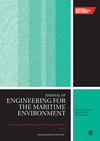通过对不同船体结构进行 CFD 分析,研究 150 米电动双体船的二氧化碳减排情况
IF 1.5
4区 工程技术
Q3 ENGINEERING, MARINE
Proceedings of the Institution of Mechanical Engineers, Part M: Journal of Engineering for the Maritime Environment
Pub Date : 2024-06-20
DOI:10.1177/14750902241257563
引用次数: 0
摘要
使用 CFD 分析了 Incat Tasmania 提出的 150 米电动穿浪双体船概念,以探讨运行速度和船体分离度对船舶性能和二氧化碳减排的流体力学影响。在 0.2 < Fr < 0.4 的调查航速范围内,对四种船体分离比(s/ L)和两种船体细长比(L/∇1/3)的干扰因素进行了评估。作为容器总阻力的函数,显示了生命周期内二氧化碳总排放量的影响,并讨论了其意义。s/ L = 0.220 的分离比提供了最低的总阻力,但其他配置在特定的弗劳德数下提供了更好的结果。引入了运输能力的概念,并通过确定临界 Froude 数 Fr = 0.35 来证明电动动力系统速度较慢的优势,在临界 Froude 数 Fr = 0.35 以上,由于镍锰钴(NMC)电池的能量密度较低,运输能力会降低。此外,还对电动动力系统与等效的液化天然气和柴油动力系统进行了比较,以证明燃料碳强度对标准化船舶二氧化碳排放量的影响。通过对电动船的运输能力和减排效果进行分析,提出了 Fr = 0.28 的速度作为两者之间的折中速度,通过采用 s/ L = 0.151 的较窄船体分离比,可在此速度附近实现进一步的功率和减排效果。本文章由计算机程序翻译,如有差异,请以英文原文为准。
Investigation of CO2 emissions reduction for a 150 m electric catamaran by CFD analysis of various hull configurations
A 150 m electric wave-piercing catamaran concept from Incat Tasmania is analysed using CFD to explore the hydrodynamic impact of operating speed and hull separation on vessel performance and CO2 emissions reduction. Over the investigated speed range of 0.2 < Fr < 0.4, interference factors are evaluated for four demihull separation ratios ( s/ L) and two demihull slenderness ratios ( L/∇1/3 ). The implications on total life-cycle CO2 emissions are presented as a function of total vessel resistance, and the significance discussed. A separation ratio of s/ L = 0.220 provides the lowest overall resistance, however other configurations provide superior results for specific Froude numbers. The concept of transportation capacity is introduced and used to demonstrate the advantage of slower speeds for the electric powertrain through identification of a critical Froude number Fr = 0.35, above which transportation capacity is reduced as a consequence of the low energy density of Nickel Manganese Cobalt (NMC) batteries. A comparison is also made between the electric and equivalent LNG and diesel powertrains to demonstrate the effect of fuel carbon intensities on standardised vessel CO2 emissions. Through analysis of the transportation capacity and emissions reduction of the electric vessel, a speed of Fr = 0.28 is proposed as a compromise between the two, with further power and emissions reductions achievable near this speed by adopting a narrower hull separation ratio of s/ L = 0.151.
求助全文
通过发布文献求助,成功后即可免费获取论文全文。
去求助
来源期刊

CiteScore
3.90
自引率
11.10%
发文量
77
审稿时长
>12 weeks
期刊介绍:
The Journal of Engineering for the Maritime Environment is concerned with the design, production and operation of engineering artefacts for the maritime environment. The journal straddles the traditional boundaries of naval architecture, marine engineering, offshore/ocean engineering, coastal engineering and port engineering.
 求助内容:
求助内容: 应助结果提醒方式:
应助结果提醒方式:


